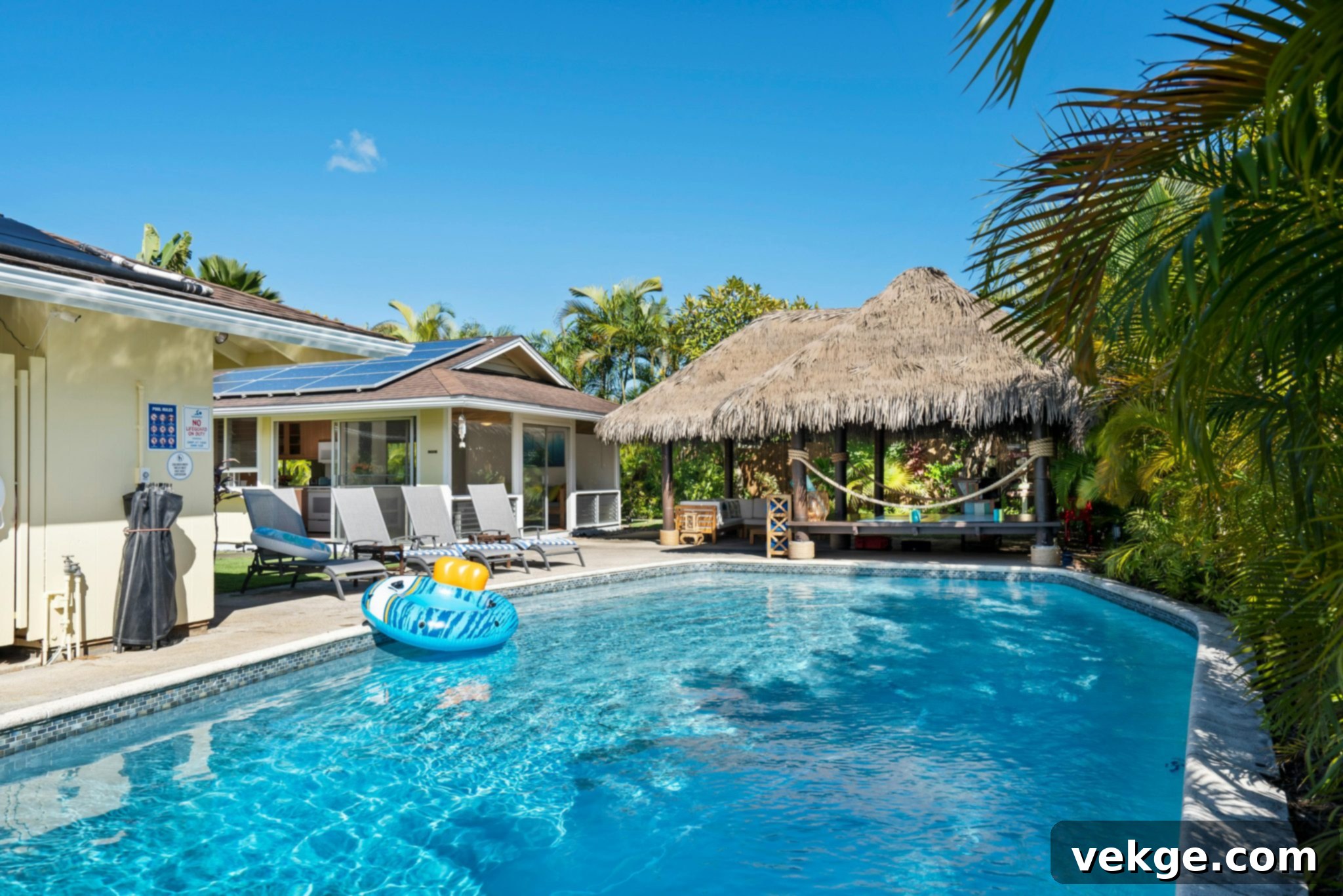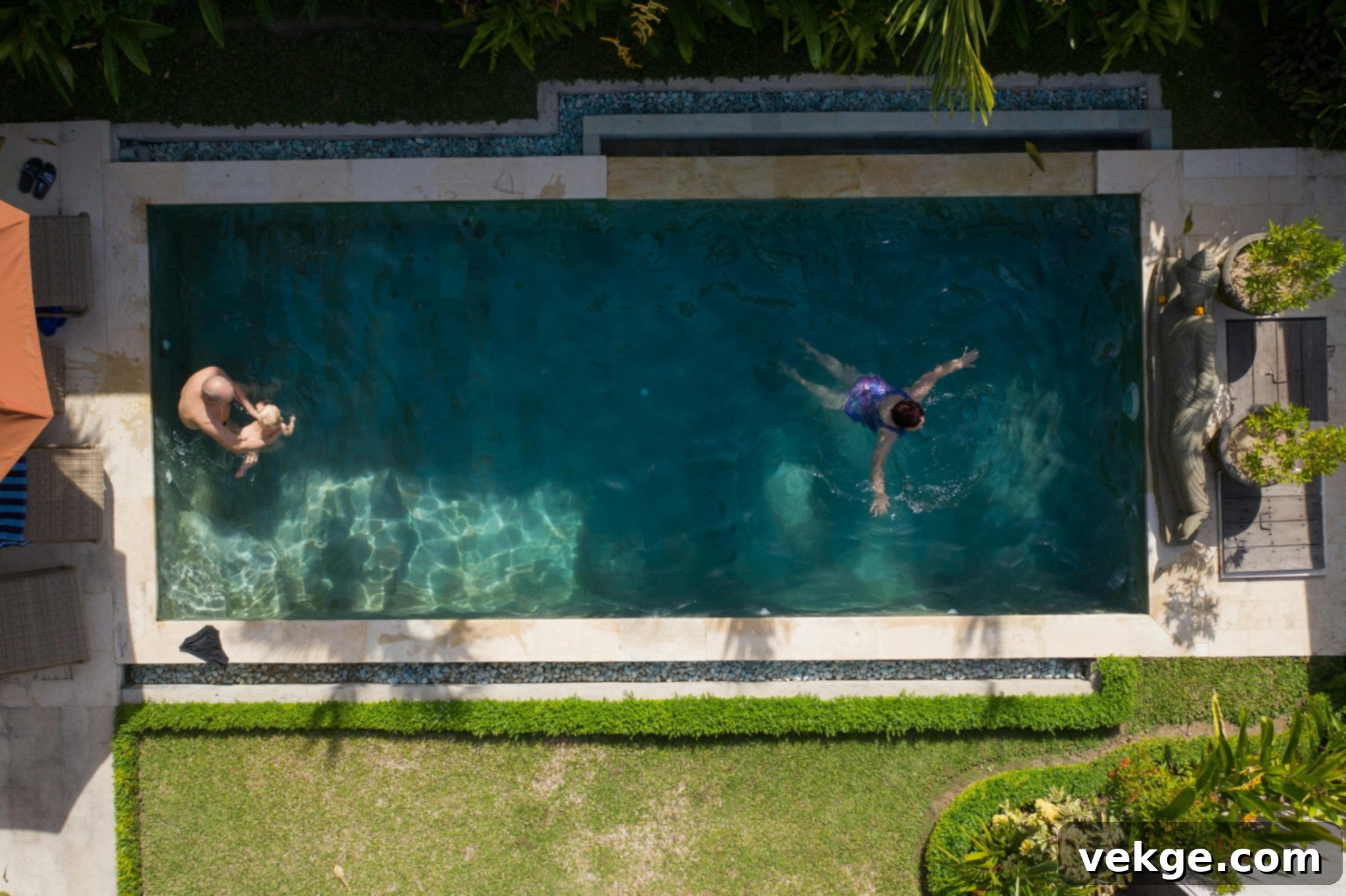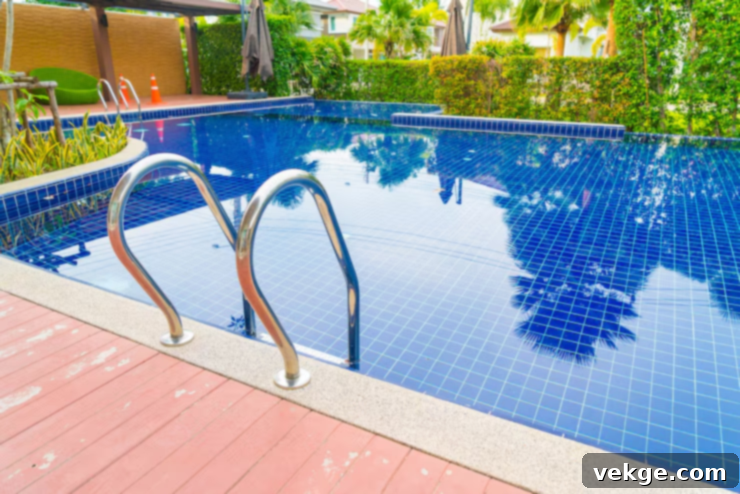Achieve Crystal Clear Waters: Your Ultimate Guide to Essential Pool Maintenance Tips
Source: Freepik.com
For many homeowners, a swimming pool is more than just a backyard feature; it’s a personal oasis, a place for relaxation, exercise, and creating lasting memories. However, the dream of a pristine, crystal clear pool throughout the swimming season often comes with the practical challenge of consistent and effective maintenance. Are you wondering how to maintain your home’s pool to ensure its sparkling clarity, optimal functionality, and lasting longevity?
Achieving and sustaining a healthy, inviting swimming environment requires a systematic approach to pool care. Neglecting routine maintenance can quickly lead to cloudy water, algae blooms, equipment malfunctions, and even potential health risks for swimmers. This comprehensive guide will walk you through essential pool maintenance tips, designed to empower you with the knowledge and strategies needed to keep your pool in perfect condition, ensuring a safe, healthy, and enjoyable swimming experience for everyone.
Daily, Weekly, and Monthly Pool Cleaning Routines for Sparkling Water

Regular physical cleaning is the foundation of effective pool maintenance. It’s your first line of defense against the accumulation of debris, organic matter, and the initial stages of algae and bacteria growth. A clean pool doesn’t just look inviting; it also reduces the strain on your filtration system and chemical balance. This process involves several key steps:
1. Skimming the Pool Surface
- Daily Ritual: Make it a habit to skim your pool surface daily, or even multiple times a day if your pool is under trees or exposed to high winds. Use a long-handled skimmer net to remove all leaves, insects, pollen, and other floating debris.
- Preventative Measure: Timely skimming prevents organic matter from sinking to the bottom, where it can decompose, provide nutrients for algae, and clog your skimmer and pump baskets.
2. Brushing Pool Walls and Floor
- Weekly Necessity: To prevent the build-up of algae and stains, you must brush the pool walls, steps, and floor on a weekly basis. Even if your pool looks clean, microscopic algae spores and dirt can cling to surfaces, forming an invisible film.
- Proper Tools: Use a brush appropriate for your pool surface (nylon for vinyl or fiberglass, wire for concrete/gunite). Pay special attention to corners, crevices, and areas with poor circulation.
3. Vacuuming the Pool
- Regular Deep Clean: Vacuuming is essential for removing debris that has settled to the bottom. Depending on pool usage and environmental factors, vacuum at least once a week, or more frequently as needed.
- Manual vs. Automatic: You can use a manual vacuum cleaner with a telescopic pole and hose connected to your skimmer or dedicated vacuum line. Alternatively, robotic or automatic pool cleaners offer convenience, autonomously cleaning your pool floor and walls.
4. Cleaning and Backwashing the Pool Filter
- Crucial for Clarity: Your pool filter is the workhorse of your circulation system, removing tiny particles that contribute to cloudy water. Neglecting filter maintenance compromises its efficiency and places extra strain on your pool pump.
- Backwashing (Sand & DE Filters): For sand and diatomaceous earth (DE) filters, backwash regularly as instructed by the manufacturer, typically when the pressure gauge reads 8-10 PSI above its clean operating pressure. This reverses water flow to flush out trapped debris.
- Cartridge Cleaning: For cartridge filters, remove and thoroughly rinse the cartridges with a hose on a routine schedule, often every 4-6 weeks, or when pressure increases. Deep cleaning with a specialized filter cleaner is recommended seasonally.
Thorough Pool Equipment Inspection for Safety and Longevity
Your pool’s operational health relies heavily on its various equipment components working in harmony. Regular inspection is paramount not just for maintaining crystal clear water, but also for ensuring the safety, longevity, and proper functionality of your entire pool system. This proactive approach helps you identify and repair potential damages before they escalate into major issues, which could lead to costly replacements or downtime. When inspecting your pool equipment, you must systematically check various components:
1. Pool Heater Assessment
- Functionality Check: Ensure the heater is functioning correctly, heating the water to your desired temperature efficiently. Listen for unusual noises and check for any error codes on digital displays.
- Safety & Connections: Inspect safety features, controls, and all venting components for blockages or corrosion. For gas heaters, check gas lines for leaks; for electric, examine wiring and connections. Consider annual professional servicing to ensure peak performance and safety.
2. Pool Pump Examination
- Leak Detection: Carefully check for leaks around the motor, connections, and the pump housing itself. Even small drips can indicate a seal problem.
- Noise and Flow: Listen for any unusual noises such as grinding, squealing, or humming, which may indicate worn bearings or a failing motor. Note if there is any reduced water flow from the return jets, as this could signal an impeller blockage or a filter issue.
- Strainer Basket: Regularly empty the pump’s strainer basket to ensure optimal water flow and prevent debris from reaching the impeller.
3. Filter Integrity Check
- Visual Inspection: Inspect your pool filter for any visible cracks, damage to the housing, or signs of rust on metal clamps or parts.
- Pressure Gauge: Monitor the pressure gauge on your filter. An unusually high or low reading can indicate problems like a clogged filter, pump issues, or a leak in the system.
4. Electrical Components Safety
- Wiring and Grounding: Must check all visible wiring, grounding connections, and bonding for potential issues like fraying, corrosion, or loose connections.
- GFCI Outlets: Ensure all Ground Fault Circuit Interrupter (GFCI) outlets near the pool area are functioning correctly. Test them monthly. Electrical safety around water is non-negotiable.
5. Other Essential Equipment Checks
- Skimmer Baskets: Ensure they are intact and regularly emptied.
- Return Jets: Check for proper water flow and direction.
- Automatic Cleaner: If you have one, ensure it’s moving freely and cleaning effectively.
- Lights: Test underwater and surrounding pool lights for functionality.
If you are a homeowner and facing challenges in pool equipment maintenance, or if you suspect a major issue, it’s wise to consider professional services. Companies like DFW pool repair are skilled and can offer expert assistance. These professionals possess years of knowledge and experience in addressing various pool issues, from intricate electrical problems to complex pump diagnostics, and can provide you with high-quality services tailored to your specific needs, offering peace of mind and ensuring the longevity of your pool system.
Maintaining Optimal Circulation: Keep Your Pool Pump Running

The pool pump is the heart of your pool’s circulation system. A properly running pool pump is absolutely essential for maintaining a healthy, clean, and balanced pool environment. It continuously circulates the water, pushing it through the filter, distributing chemicals, and preventing stagnation. Therefore, to ensure the water is safe, clean, and will not cause any damage to the pool parts and equipment, you must keep your pool pump running for an adequate amount of time each day. This critical operation ensures several key benefits:
1. Proper Chemical Distribution
- Even Dispersal: A running pump ensures that chemicals and sanitizers, such as chlorine, are evenly distributed throughout the entire pool. Without proper circulation, chemicals would settle in certain areas, leading to inconsistent sanitation and potential “dead spots” where algae and bacteria can thrive.
- Effective Treatment: This even distribution is crucial for the chemicals to work effectively in neutralizing contaminants and maintaining the correct water chemistry across all areas of the pool.
2. Stagnation Prevention and Water Quality
- Algae and Bacteria Control: Stagnant water serves as an ideal breeding ground for bacteria, algae, and insect larvae. This can rapidly lead to cloudy water, unpleasant odors, and numerous health risks for swimmers.
- Continuous Filtration: A running pool pump prevents stagnation by constantly drawing water through the filter, removing suspended particles and debris. This continuous filtration maintains the clarity and overall quality of your pool water, keeping it inviting and safe.
3. Optimal Run Times for Efficiency
- Factors to Consider: The ideal run time for your pool pump depends on several factors, including pool size, bather load, local climate, and the efficiency of your filtration system.
- General Recommendation: Most experts recommend running your pool pump for at least 8-12 hours per day. During peak swimming season or periods of heavy use, you might need to run it longer.
- Energy Efficiency: Consider investing in a variable-speed pump, which can significantly reduce energy consumption by running at lower speeds for longer periods, achieving better filtration for less cost.
Mastering Water Chemistry: Test and Balance the Pool Water
Understanding and maintaining proper pool water chemistry is perhaps the most critical aspect of pool maintenance. Properly balanced water provides you with a healthy and safe pool environment, minimizing the risk of eye and skin irritation for swimmers. Conversely, imbalanced water can be corrosive to your pool surface and equipment, leading to premature wear, staining, and costly repairs and replacements over time. Therefore, you must diligently test and balance the pool water to enjoy comfortable, crystal clear swimming without any problems.
1. pH Levels
- Definition: pH measures the acidity or basicity of your pool water.
- Ideal Range: You must maintain a pH level between 7.4 and 7.6, which is slightly alkaline and considered neutral for human eyes and skin, similar to tears.
- Consequences of Imbalance:
- Low pH (acidic): Indicates your pool water is acidic. This can cause eye and skin irritation, corrode metal components (heaters, ladders), etch plaster, and rapidly deplete chlorine.
- High pH (basic): A sign of basic nature. High pH reduces chlorine effectiveness, causes cloudy water, and can lead to scale formation on pool surfaces and equipment.
- Adjustment: Use pH Increaser (soda ash) to raise pH or pH Decreaser (muriatic acid or dry acid) to lower it.
2. Total Alkalinity (TA)
- Definition: Total Alkalinity acts as a pH buffer, helping to mitigate extreme fluctuations in acidity or basicity, thus stabilizing your pH.
- Ideal Range: Its ideal range is considered to be 100-150 parts per million (ppm), with 120 ppm often being the sweet spot.
- Consequences of Imbalance:
- Low TA: Causes pH to “bounce” wildly, making it difficult to maintain balance.
- High TA: Can lead to cloudy water and make it difficult to adjust pH.
- Adjustment: Use Alkalinity Increaser (sodium bicarbonate or baking soda) to raise TA. Muriatic acid can lower TA, but it also lowers pH.
3. Sanitizer Levels (Chlorine is Most Common)
- Definition: Sanitizers kill bacteria, viruses, and algae, keeping your water safe. Chlorine is the most widely used.
- Ideal Range (Free Chlorine): Maintain free chlorine levels between 1-3 ppm for most residential pools.
- Consequences of Imbalance:
- Low Chlorine: Ineffective sanitation, leading to algae growth and bacterial contamination.
- High Chlorine: Can cause skin and eye irritation, damage pool equipment, and fade swimsuits.
- Shocking: Periodically “shock” your pool (super-chlorinate it) to break down contaminants, clear cloudy water, and kill stubborn algae.
4. Calcium Hardness (CH)
- Definition: Measures the amount of dissolved calcium in your water.
- Ideal Range: 200-400 ppm.
- Consequences of Imbalance:
- Low CH: “Soft” water can be corrosive, dissolving minerals from plaster, grout, and metal equipment.
- High CH: “Hard” water leads to scale buildup on surfaces and equipment, reducing efficiency and potentially causing damage.
- Adjustment: Use Calcium Hardness Increaser to raise levels. Lowering high CH often requires partial draining and refilling with softer water.
5. Cyanuric Acid (CYA)
- Definition: CYA, or conditioner, stabilizes chlorine, protecting it from degradation by UV rays.
- Ideal Range: 30-50 ppm for chlorinated outdoor pools.
- Consequences of Imbalance:
- Low CYA: Chlorine dissipates quickly, requiring more frequent additions.
- High CYA: Can cause “chlorine lock,” where chlorine becomes ineffective despite high readings.
- Adjustment: Add CYA to increase levels. Lowering high CYA requires partial draining and refilling.
Testing Methods and Frequency
- Tools: Use reliable test strips, liquid test kits, or digital testers.
- Frequency: Test pH and sanitizer levels 2-3 times per week, or even daily during heavy use or hot weather. Test alkalinity, calcium hardness, and CYA weekly or bi-weekly.
- Professional Testing: Consider having your water professionally tested by a pool supply store or service company monthly for a more comprehensive analysis.
Embrace Consistency for a Lifetime of Pool Enjoyment
Maintaining a swimming pool doesn’t have to be an overwhelming chore. By adopting a consistent and systematic approach to the tips outlined above – regular cleaning, thorough equipment inspections, ensuring proper circulation, and diligent water chemistry balancing – you can transform the task into a manageable routine.
The reward for your efforts is immense: a safe, healthy, and visually stunning swimming pool that enhances your property’s value and provides endless hours of enjoyment for you, your family, and your friends. Remember, proactive maintenance not only prevents costly repairs but also extends the life of your pool and its components. So, dive into these essential practices today and ensure your backyard oasis remains a sparkling retreat for many seasons to come!
